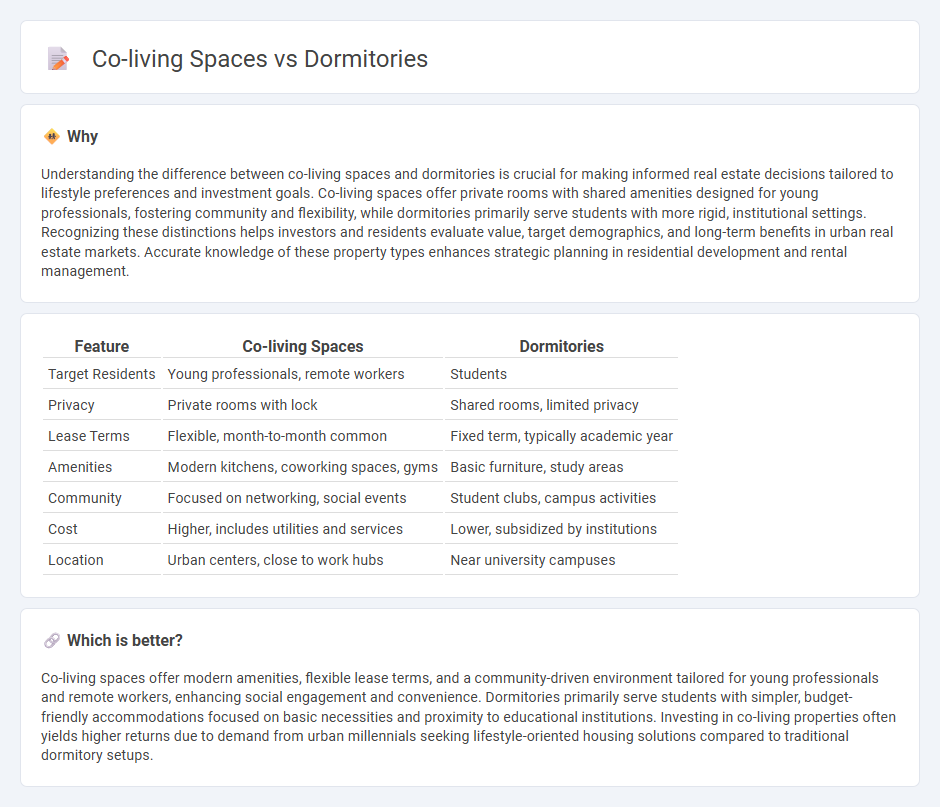
Co-living spaces offer modern, fully furnished environments designed for young professionals seeking community and flexibility, contrasting with dormitories that traditionally house students with basic amenities and structured living arrangements. These residential options differ significantly in terms of amenities, privacy levels, and social engagement opportunities. Explore the key differences to determine which living concept suits your lifestyle and housing needs best.
Why it is important
Understanding the difference between co-living spaces and dormitories is crucial for making informed real estate decisions tailored to lifestyle preferences and investment goals. Co-living spaces offer private rooms with shared amenities designed for young professionals, fostering community and flexibility, while dormitories primarily serve students with more rigid, institutional settings. Recognizing these distinctions helps investors and residents evaluate value, target demographics, and long-term benefits in urban real estate markets. Accurate knowledge of these property types enhances strategic planning in residential development and rental management.
Comparison Table
| Feature | Co-living Spaces | Dormitories |
|---|---|---|
| Target Residents | Young professionals, remote workers | Students |
| Privacy | Private rooms with lock | Shared rooms, limited privacy |
| Lease Terms | Flexible, month-to-month common | Fixed term, typically academic year |
| Amenities | Modern kitchens, coworking spaces, gyms | Basic furniture, study areas |
| Community | Focused on networking, social events | Student clubs, campus activities |
| Cost | Higher, includes utilities and services | Lower, subsidized by institutions |
| Location | Urban centers, close to work hubs | Near university campuses |
Which is better?
Co-living spaces offer modern amenities, flexible lease terms, and a community-driven environment tailored for young professionals and remote workers, enhancing social engagement and convenience. Dormitories primarily serve students with simpler, budget-friendly accommodations focused on basic necessities and proximity to educational institutions. Investing in co-living properties often yields higher returns due to demand from urban millennials seeking lifestyle-oriented housing solutions compared to traditional dormitory setups.
Connection
Co-living spaces and dormitories both provide shared housing solutions that maximize space efficiency and foster community living, appealing mainly to young professionals and students. Real estate developments increasingly invest in these models to meet the rising demand for affordable, flexible housing in urban areas. The growing trend toward hybrid living environments highlights the blurred lines between traditional dormitory setups and modern co-living apartments.
Key Terms
Shared Amenities
Dormitories typically offer basic shared amenities such as communal bathrooms, kitchens, and common study areas designed primarily for students, emphasizing affordability and functionality. Co-living spaces provide a more extensive range of shared amenities including high-speed Wi-Fi, fitness centers, social lounges, and organized community events aimed at fostering interaction and convenience for young professionals. Discover how these differences in shared amenities impact your living experience and community engagement.
Lease Flexibility
Dormitories typically offer fixed lease terms aligned with academic semesters, limiting flexibility for students needing short-term stays. Co-living spaces provide diverse lease options, including month-to-month agreements, accommodating itinerant professionals and remote workers with unpredictable schedules. Explore more about how lease flexibility in these housing types can suit your lifestyle needs.
Community Engagement
Dormitories foster community engagement through shared facilities and organized social events that encourage interaction among residents. Co-living spaces emphasize a stronger sense of belonging by offering curated communal activities, collaborative workspaces, and personalized support networks. Explore the distinctive approaches of dormitories and co-living spaces to community engagement for a deeper understanding.
Source and External Links
Dormitory - A building primarily providing sleeping and residential quarters for large numbers of people, such as students or travelers.
Student Accommodations: What Will My Dormitory Be Like ... - This webpage describes typical dormitory options in the US, including shared rooms, suites, and apartments.
2025 Best College Dorms & Rooms in America - A ranking of colleges with the best dorms based on safety, cleanliness, amenities, and student reviews.
 dowidth.com
dowidth.com